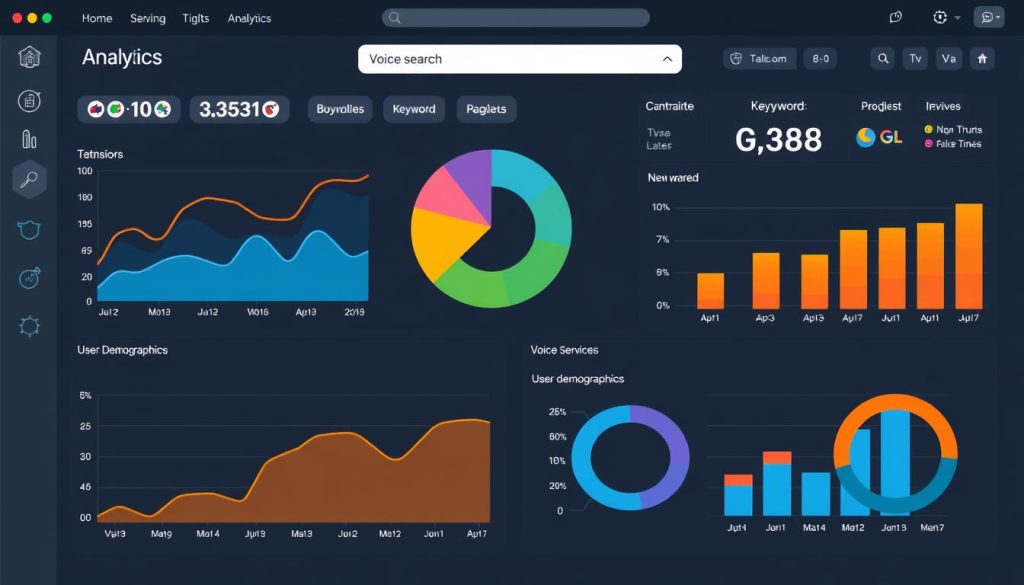Voice search optimisation is now a key part of SEO strategies. With more people using voice assistants, businesses must adapt to stay relevant. This guide will cover how to optimise your content for voice search, helping you rank better and reach more people.
We’ll dive into the technology behind voice assistants and practical SEO strategies for voice queries. By the end, you’ll know how to make your website more visible in voice search results. This will give you an edge in the digital world.
Key Takeaways
- Voice search optimisation is essential for modern SEO strategies
- Understanding voice assistant technology is key for effective optimisation
- Natural language and conversational content are vital for voice search success
- Local SEO is important for voice search rankings
- Mobile optimisation is critical for voice search performance
- Structured data and featured snippets can enhance voice search visibility
Understanding Voice Search Technology and Its Impact
Voice search technology has revolutionised how we interact with digital devices. It employs voice recognition to process spoken queries, delivering relevant results. This innovation has changed the way we access information.
The Evolution of Voice Search Technology
The history of voice search starts with basic voice recognition systems. These early systems were often inaccurate and had limited vocabularies. Now, AI-powered voice assistants like Siri, Alexa, and Google Assistant can handle complex queries and natural speech patterns.

How Voice Assistants Process Queries
Voice assistants employ advanced algorithms to understand and respond to queries. They break down spoken words into phonemes, match them against known patterns, and use context to determine the query’s intent. This enables more natural and conversational interactions.
Current Market Share of Voice Search
The voice search market has experienced rapid growth in recent years. A significant number of internet users now use voice-activated devices for their daily searches. Here’s a look at the current market distribution among major voice assistants:
| Voice Assistant | Market Share (%) | Primary Device |
|---|---|---|
| Google Assistant | 36 | Smartphones |
| Siri | 25 | iPhones |
| Alexa | 22 | Smart Speakers |
| Others | 17 | Various |
As the voice search market grows, businesses must adjust their SEO strategies to stay competitive in this evolving digital world.
Why Voice Search Matters for Modern SEO
Voice search is transforming the digital world, becoming essential for modern SEO strategies. With the rise of smart speakers and mobile voice assistants, user habits and search patterns are changing fast. This evolution is altering how we interact with search engines and access information online.

The growth of voice search has major implications for website visibility. Traditional SEO methods may not be effective for capturing voice-based queries, which are often more conversational and question-based. To remain competitive, businesses must adjust their SEO strategies to meet this trend.
Voice search importance goes beyond convenience. It’s becoming a preferred choice for many, ideal for multitasking or seeking quick answers. This shift in user behaviour is pushing SEO trends towards more natural language optimisation and featured snippet targeting.
“Voice search is not just a trend; it’s the future of how we interact with technology and find information.”
Optimising for voice search can benefit websites in several ways:
- Improve local search visibility
- Enhance mobile user experience
- Capture featured snippet positions
- Increase overall organic traffic
As voice technology advances, its influence on SEO will increase. Businesses that adopt voice search optimisation now will be ahead in meeting user needs and staying competitive in the digital market.
Key Differences Between Text and Voice Search Behaviour
The advent of voice search has dramatically altered how we interact with search engines. Grasping these changes is essential for refining your SEO tactics.
Natural Language Processing in Voice Queries
Voice search heavily depends on natural language queries. People converse with their devices as they would with a person, employing conversational phrases and full sentences. This is in stark contrast to typed searches, which typically comprise fragmented keywords.

Question-Based Search Patterns
Voice searches often manifest as questions. Users are inclined to ask “Where’s the nearest pizza shop?” instead of typing “pizza shop near me”. This shift towards interrogative queries demands a distinct approach to content creation and keyword optimisation.
Local Search Intent in Voice Queries
Local voice search is a dominant trend in voice queries. Users frequently seek immediate, location-specific information, such as business hours or directions. This highlights the critical role of optimising for local SEO to effectively capture voice search traffic.
“Voice search is transforming our SEO perspectives. It transcends mere keywords; it delves into user intent and natural language patterns.”
By acknowledging these fundamental differences in voice search behaviour, businesses can tailor their SEO strategies to align with voice search user needs. This adaptation will enhance their presence in the burgeoning voice search landscape.
Essential Elements of SEO for Voice Search
Voice search SEO elements are transforming the digital world. As voice-activated searches become more popular, businesses must adjust their strategies. Let’s dive into the key elements that ensure success in voice search optimisation.

Long-tail keywords are vital in voice search. Unlike text searches, voice queries are often more conversational and specific. Using these natural-language phrases in your content can greatly increase your visibility.
Creating content focused on answering questions is another critical aspect. Voice assistants frequently draw from featured snippets. Structuring your content to directly answer common questions is essential. This not only boosts your chances in voice search results but also improves user experience.
“Optimising for voice search is not just about technology; it’s about understanding human conversation patterns and adapting our content.”
Local SEO is also key for voice search. Many voice queries are location-based, seeking services or information nearby. Ensuring your business details are accurate and consistent across all platforms can improve your visibility in voice search.
| Voice Search SEO Element | Importance | Implementation Strategy |
|---|---|---|
| Long-tail Keywords | High | Use natural language in content |
| Answer-focused Content | Critical | Structure content to directly answer questions |
| Local SEO | Essential | Maintain consistent business information across platforms |
| Page Speed | High | Optimise website loading times |
| Mobile Optimisation | Critical | Ensure mobile-friendly website design |
By incorporating these voice search SEO elements and optimisation techniques, you can significantly boost your online presence. This is essential for catering to the increasing number of voice search users.
Optimising Content for Conversational Queries
Voice search has revolutionised our interaction with search engines. To remain competitive, we must adapt our content to align with these conversational queries. Let’s dive into essential strategies for optimising your content.
Understanding User Intent
Understanding user intent is essential for creating voice-friendly content. Users of voice search often seek quick answers or local information. By anticipating these needs, you can craft content that delivers immediate value.

Implementing Long-tail Keywords
Long-tail keywords are critical for voice search optimisation. These phrases closely mirror natural speech patterns, making them perfect for voice queries. Incorporate these keywords naturally into your content to enhance relevance.
Creating Natural Language Content
Voice searches are more conversational. Write content that mirrors how people speak, using complete sentences and question-based formats. This approach aligns with user intent, increasing your visibility in voice search results.
| Content Type | Optimisation Strategy | Example |
|---|---|---|
| FAQ Pages | Use question-based headers | “How do I optimise for voice search?” |
| Blog Posts | Incorporate conversational phrases | “Let’s dive into voice search optimisation” |
| Product Descriptions | Include natural language benefits | “This gadget saves you time by…” |
By focusing on these elements, you’ll create content that resonates with voice search users and aligns with their queries. The key is to find a balance between SEO optimisation and natural, engaging content.
Technical Requirements for Voice Search Optimisation
Voice search optimisation demands specific technical tweaks to your website. These adjustments ensure your content is accessible to voice assistants. Let’s dive into the essential technical requirements for voice search success.
Mobile Optimisation
Voice searches predominantly happen on mobile devices. Your site must be mobile-friendly to serve these users. It’s vital to have responsive design, touch-friendly buttons, and readable text on small screens. A mobile-optimised site enhances user experience and boosts voice search rankings.

Page Speed Requirements
Voice search users expect swift answers. Your website must load quickly to meet these expectations. Aim for load times under three seconds. Use image compression, code minification, and browser caching to enhance page speed. Fast-loading pages are more likely to be selected for voice search results.
Schema Markup Implementation
Schema markup aids search engines in understanding your content better. It’s invaluable for voice search, enabling direct answers to common questions. Implement schema markup for your business details, FAQs, and product information. This structured data facilitates voice assistants in retrieving relevant information from your site.
- Use JSON-LD format for schema markup
- Include relevant properties like name, address, and opening hours
- Test your schema markup using Google’s Structured Data Testing Tool
By concentrating on these technical elements – mobile optimisation, page speed, and schema markup – you’ll lay a strong foundation for voice search success. Remember, voice search optimisation is a continuous endeavour, so continually test and refine your strategy.
Local SEO Strategies for Voice Search
Voice search is revolutionising how we discover local businesses. With more people using voice assistants for local searches, optimising for voice search is now essential. This change requires a new strategy for local business optimisation.

To enhance your visibility in local voice search, start by claiming and optimising your Google My Business listing. Make sure your business name, address, and phone number are the same everywhere online. This consistency helps voice assistants give accurate info to users.
Creating content specific to your location is another smart move. Develop pages or blog posts about local topics, events, or landmarks. This strategy boosts your chances of showing up in voice search results for local queries.
“Voice search is not just a trend; it’s the future of local business discovery.”
Using local keywords effectively is vital for voice search success. Target long-tail, conversational phrases that users might say to their devices. For instance, instead of “best Italian restaurant,” aim for “Where’s the best Italian restaurant near me?”
- Optimise for “near me” searches
- Include local landmarks in your content
- Use schema markup to provide context
- Encourage and respond to customer reviews
By adopting these strategies, you’ll increase your visibility in local voice searches. The aim is to be the most relevant and accessible choice for voice-driven local queries.
Featured Snippets and Position Zero Optimisation
Featured snippets are critical in voice search results, often referred to as position zero. They sit atop search engine results pages, delivering swift answers to user queries. This makes them perfect for optimising voice search.

Creating Answer-Focused Content
To boost your chances of getting a featured snippet, focus on creating content that answers questions directly. Use straightforward language and present information in formats like lists or tables. This makes it easy for users to find what they need.
For instance, if you’re aiming for the query “How to optimise for voice search?”, your content should be structured as follows:
- Use long-tail keywords
- Create conversational content
- Optimise for local search
- Improve page speed
- Implement structured data
Structured Data Best Practices
Structured data enhances search engine understanding of your content, boosting your chances of featured snippets. Employ schema markup to offer context about your content. Here are some key practices:
| Best Practice | Description |
|---|---|
| Use relevant schema types | Choose schema types that align with your content (e.g., FAQ, How-to, Recipe) |
| Implement JSON-LD | JSON-LD is easier to implement and maintain |
| Test your markup | Google’s Structured Data Testing Tool ensures correct implementation |
| Keep it up-to-date | Regularly update structured data to reflect content changes |
Adopting these practices will enhance your chances of securing featured snippets and optimising for voice search queries.
Voice Search Analytics and Performance Tracking
Measuring the success of voice search optimisation can be tricky, but it’s vital for refining your strategies. Let’s explore ways to track and analyse voice search performance effectively.

To gauge the impact of voice search on your website, focus on these key voice search metrics:
- Conversion rate from voice queries
- Click-through rate for featured snippets
- Voice search bounce rate
- Average session duration for voice search traffic
Performance analysis tools can help you identify voice search queries in your analytics data. Google Search Console and Google Analytics are excellent starting points for tracking these metrics.
One challenge in voice search analytics is distinguishing voice queries from text-based searches. To overcome this, look for longer, more conversational phrases and question-based queries in your search terms report.
| Metric | Importance | How to Track |
|---|---|---|
| Featured Snippet Appearances | High | Google Search Console |
| Local Pack Rankings | Medium | Local SEO Tools |
| Long-tail Keyword Performance | High | Keyword Research Tools |
Remember, optimising for local SEO is key for voice search success. Keep an eye on your local pack rankings and featured snippet appearances to track your progress in the voice search world.
Common Voice Search Optimisation Mistakes to Avoid
Voice search optimisation can be complex, and many businesses unknowingly make mistakes. Understanding these errors can help enhance your website’s voice search performance.
Ignoring Mobile Optimisation
One major error is overlooking mobile optimisation. Most voice searches occur on mobiles. Your site must be mobile-friendly. It should load quickly, have a responsive design, and provide a seamless experience on all mobile devices.

Neglecting Local SEO
Local SEO is vital for voice search success. Many voice queries are location-based, like “find a coffee shop near me”. If you’re not optimising for local search, you’re losing out on valuable traffic. Ensure your business details are current on Google My Business and other local directories.
Poor Content Structure
Poor content structure is another common error. Voice assistants prefer content that’s straightforward and easy to understand. Use clear headings, short paragraphs, and bullet points. Also, aim to answer specific questions your audience might have.
| Optimisation Mistake | Impact on Voice Search | How to Fix |
|---|---|---|
| Ignoring Mobile Optimisation | Reduced visibility in mobile voice searches | Implement responsive design, improve page speed |
| Neglecting Local SEO | Missing out on local voice queries | Optimise Google My Business, target local keywords |
| Poor Content Structure | Difficulty in extracting relevant information | Use clear headings, concise paragraphs, and FAQ formats |
Avoiding these common voice search mistakes and addressing optimisation errors can greatly improve your website’s voice search performance.
Future Trends in Voice Search Technology
Voice search technology is rapidly evolving, reshaping how we interact with digital devices. As we look ahead, several exciting voice search trends are emerging that will significantly impact SEO strategies.

The future of voice assistants is poised for remarkable growth. Experts predict a surge in voice-activated smart home devices. Voice commands will become the primary interface for controlling household appliances, lighting, and security systems.
Natural language processing is set to become more sophisticated. This will enable voice assistants to understand context, emotions, and even sarcasm. Such advancements will lead to more natural and engaging conversations between users and AI-powered assistants.
Another significant trend is the integration of voice search with augmented reality (AR) and virtual reality (VR) technologies. Imagine asking your voice assistant to display product information while browsing a virtual store. Or getting real-time translations during a conversation with someone speaking a different language.
| Voice Search Trend | Potential Impact on SEO |
|---|---|
| Multilingual voice recognition | Need for localised content optimisation |
| Voice commerce | Emphasis on product-specific voice queries |
| Personalised voice experiences | Focus on user intent and contextual relevance |
As these trends unfold, businesses must adapt their SEO strategies to remain competitive in the voice search landscape. Focusing on conversational keywords, creating concise and informative content, and optimising for local searches will be key for success in this evolving digital ecosystem.
Voice Search Optimisation Tools and Resources
Exploring voice search optimisation can seem overwhelming. Fortunately, a variety of tools and resources are available to simplify your efforts. Let’s look at some key tools and platforms that can boost your voice search strategy.
Recommended Analysis Tools
Tools like SEMrush and Ahrefs are equipped with keyword research features for voice queries. They help uncover long-tail keywords and question-based phrases typical in voice searches. Google’s Natural Language API is also a valuable resource for grasping how search engines process conversational queries.
| Tool | Key Features | Best For |
|---|---|---|
| SEMrush | Keyword research, SERP analysis | Comprehensive SEO analysis |
| Ahrefs | Backlink analysis, content explorer | Link building strategies |
| Google’s Natural Language API | Entity recognition, sentiment analysis | Understanding query intent |
Voice Search Testing Platforms
For refining your voice search optimisation, consider using testing platforms. PullString and Dialogflow enable you to create and test voice applications. This helps you see how users interact with voice interfaces. These tools offer insights into user behaviour and preferences in voice search scenarios.

By utilising these voice search tools and resources, you can gain a competitive advantage in the fast-changing voice search landscape. It’s important to keep your toolkit updated as new technologies arise to remain at the forefront of voice search optimisation.
Case Studies: Successful Voice Search Optimisation
Real-world voice search success stories offer valuable lessons for businesses aiming to improve their digital presence. Let’s explore some inspiring optimisation examples that have yielded impressive results.

A prominent UK-based food delivery service revamped its website to cater to voice queries. They focused on natural language and question-based content. This led to a 22% increase in voice-driven orders within three months. Their strategy included creating FAQ pages that directly addressed common customer inquiries, optimising for local searches, and implementing schema markup.
Another success story comes from a national chain of pharmacies. They prioritised mobile optimisation and enhanced their local SEO efforts. The result? A 35% boost in ‘near me’ voice searches leading to in-store visits. Their approach centred on maintaining consistent NAP (Name, Address, Phone number) information across all online platforms and creating location-specific landing pages.
A small independent bookshop in London provides an excellent example of voice search optimisation for local businesses. By focusing on long-tail keywords and creating content that answered specific questions about book availability and store events, they experienced a 40% increase in foot traffic from voice-initiated searches.
These case studies demonstrate that effective voice search optimisation is achievable for businesses of all sizes. The key lies in understanding user intent, optimising for local searches, and creating content that directly answers customer queries.
LerriHost’s Approach to Voice Search Optimisation
At LerriHost, we’re dedicated to providing top-tier voice SEO optimisation services. Our team is always up-to-date with voice search technology advancements. This ensures our clients lead in this fast-changing field.

Our Methodology
LerriHost’s voice search optimisation strategy is rooted in deep research and custom plans. We start by examining your current voice search performance and pinpointing areas for growth. Our strategy encompasses:
- Comprehensive keyword research focused on conversational queries
- Content optimisation for natural language processing
- Implementation of schema markup for enhanced visibility
- Local SEO optimisation for voice-driven local searches
Success Metrics
To gauge the success of our voice SEO optimisation, LerriHost uses various metrics. These include:
| Metric | Description |
|---|---|
| Voice Search Visibility | Percentage of voice queries where your content appears in top results |
| Featured Snippet Acquisition | Number of featured snippets earned for voice-friendly queries |
| Local Search Performance | Improvement in local voice search rankings and visibility |
| Conversion Rate | Increase in conversions from voice search traffic |
By concentrating on these critical metrics, LerriHost ensures our voice search optimisation efforts yield real results for your business. Our dedication to excellence and data-driven approaches distinguishes us in the competitive voice SEO arena.
Conclusion
Voice search optimisation is now a key part of any modern SEO strategy. We’ve seen how adapting to voice queries is vital for staying ahead. By focusing on natural language, local intent, and mobile-friendly content, you can greatly improve your visibility in voice search results.
Success hinges on understanding user behaviour and creating content that answers their questions directly. Using long-tail keywords, optimising for featured snippets, and ensuring technical SEO is key. These steps are essential for your voice search optimisation journey.
As voice technology advances, so must your SEO approach. Keep up with the latest trends and regularly assess your voice search performance. By consistently applying the strategies from this guide, you’ll be ready to tap into the growing voice search audience. This will keep you at the forefront of digital marketing’s exciting new frontier.
